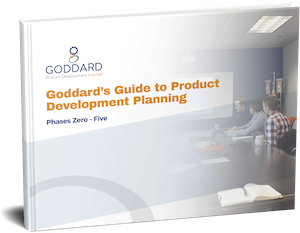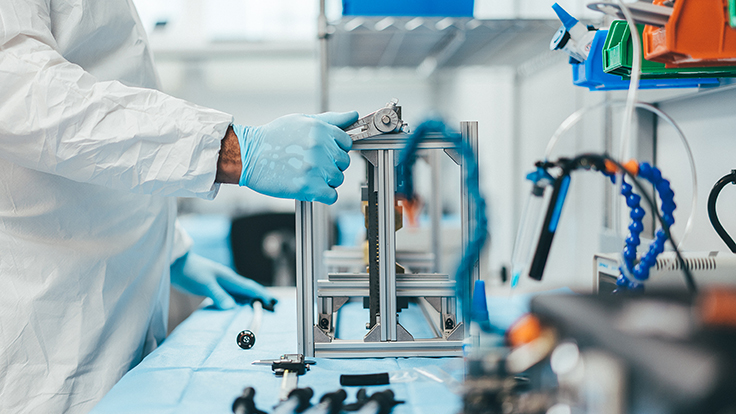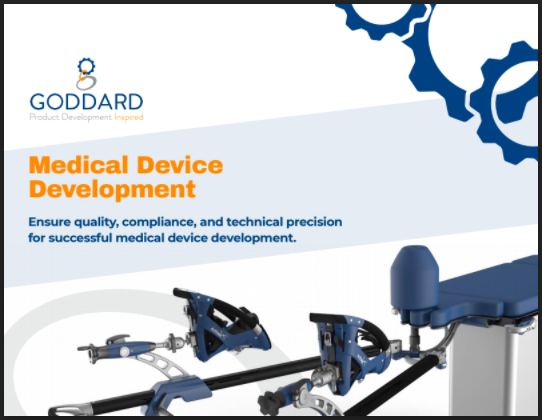Let's Work Together
Our team of experienced designers and engineers can help bring your vision to life.
Developing a medical device involves several phases that ensure successful and accessible designs, manufacturing, and market entry. Medical devices require adhering to stringent regulations and standards and an error-proof user experience (UX) and user interface (UI) design. These methods encompass a comprehensive approach to medical device development, which consists of six key phases that all developers and stakeholders must adhere to for successful production and distribution.
Before medical device development begins, the team must comprehensively define the device or system concept. This involves conducting market research, identifying user needs, and establishing key performance indicators and design requirements. Clearly defining the product’s purpose and requirements sets the foundation for efficient subsequent phases of development.
Innovative ideas are generated and evaluated in a collaborative environment, encouraging the input of every stakeholder and end-user, including patients, doctors, nurses, surgeons, maintenance technicians, and any other individual interacting with the product. Potential concepts are refined and selected for further development through brainstorming sessions, “proof-of-concept” prototypes, and feasibility studies.
The chosen concept is transformed into a detailed design. This involves creating 3D models, engineering the device components, and conducting simulations and prototypes using human factors engineering. Advanced design tools and techniques, such as Design for ‘X’ activities, including but not limited to, Design for Manufacturing (DFM), Assembly (DFA), cost, sterilization, etc.– are leveraged to ensure the complete medical device design’s accuracy, functionality, and manufacturability.
The design undergoes rigorous testing and optimization. Prototypes are extensively evaluated to validate performance, safety, and usability. Feedback from users and experts is collected and used to refine the medical device’s design and UX. This iterative process ensures that the medical device meets the highest regulatory standards and effectively addresses end-user needs.
This phase involves validating the device’s performance through clinical trials and obtaining regulatory and FDA approvals. For effective quality assurance (QA) and regulatory adherence, medical devices must submit the inputs and outputs of verification and validation tests to be reviewed by the FDA. Once validated, the manufacturing processes are established to transfer the device design into large-scale production.
The final phase involves scaling up manufacturing and bringing the medical device to the market. Your design partner will collaborate with manufacturers (Goddard provides both design and low-volume manufacturing options under one roof) to ensure the efficient production of high-quality devices. Strict quality control measures are implemented throughout the process to maintain consistency and reliability. Assessing quality and compliance throughout production should be repeated consistently until the very end so engineers can quickly address any issues that arise before completion.

Developing and bringing a medical device to market can be challenging. However, working with a knowledgeable development partner can streamline most, if not all, difficulties. Some common obstacles include:
Failure to thoroughly understand user needs can result in a device that doesn’t effectively address the requirements of healthcare professionals and patients. This includes developing a medical device that is error-prone and not user-friendly due to a lack of UI and UX expertise during the design process.
Limited resources and understaffed development teams can lead to delays, inefficiencies, and compromised quality during development. When labor is short, one of the most efficient and effective solutions can be to call in a development firm whose staff and expertise can be invaluable to overcoming your staffing issues.
Lack of expertise in medical device development, regulatory compliance, or specific technological areas can hinder the progress and success of a project. Medical device development is one of the most complex and regulated engineering verticals and can only be successfully executed through expert developers. Bringing in third-party design assistance to avoid these pitfalls is a strong strategy for avoiding development timelines that could fail.
Navigating the intricate landscape of FDA regulations and requirements can be overwhelming without proper expertise and guidance. Therefore, responsible medical device developers must have up-to-date regulatory knowledge and competency throughout the design process. For example, human factors engineering (HFE) is a vital requirement for proper medical device development and an FDA standard. Understanding how to execute HFE into medical device designs properly will ensure this doesn’t need to be implemented after the product is initially developed but throughout the entire process. Working with a development partner well-versed in these design facets is vital to proper and successful medical device development, especially if in-house knowledge or labor is limited.
Designing a device that is intuitive, user-friendly, and addresses the usability needs of healthcare professionals and patients can be a significant challenge. Complex medical devices, such as those involving software or cutting-edge technologies, can pose additional design, development, and regulatory challenges, such as increasing needs for accessibility and flawless UX and UI. Medical devices must work as intended for their end users; anything less would be unacceptable and irresponsible to produce and distribute.

To overcome these challenges and accelerate the development and market entry of medical devices, companies can take the following steps:
Partnering with experienced medical device development firms, such as Goddard Technologies , provides access to a multidisciplinary team of experts who bring a wealth of knowledge and experience to the project.
Adopting a human-centered design approach that leverages UX and UI ensures that the medical device is designed with a focus on end-users, their needs, and their workflow. This enhances usability, safety, and overall user satisfaction.
Prioritizing patient safety and satisfaction throughout development helps create error-free medical devices that improve patient outcomes and enhance their overall experience.
Partnering with a firm well-versed in FDA regulations and requirements can streamline the approval process, ensuring compliance and accelerating time-to-market for medical devices.
Working with a firm that stays current with emerging technologies, industry trends, and innovations allows medical technology companies to leverage the latest advancements, giving their products a competitive edge.
Outsourcing certain aspects of the development process to experienced firms enables companies to access specialized expertise and resources without the burden of maintaining a full-time engineering team.
Integrating functionality, marketability, and manufacturability considerations from the early stages of development helps create devices that meet user needs and are economically viable and scalable.

The medical device development process’s duration varies depending on the device’s complexity, regulatory requirements, and other factors. Generally, bringing a medical device from concept to market can take a year or many, so patience and preparation for the long haul are essential.
Most medical devices require some level of FDA approval or clearance, like 510(k) clearance , before they can be legally marketed and sold in the United States. The level of scrutiny and regulatory pathway depends on the device’s classification.
Designing a medical device involves a systematic process that includes identifying user needs, conceptualizing ideas, developing detailed designs, refining through iterative testing, validating performance, and preparing for manufacturing. Collaboration, expertise, and adherence to FDA and regulatory standards are essential throughout the design process.
The cost of developing a medical device can vary significantly depending on various factors, including the complexity of the device, the level of innovation involved, the required regulatory approvals, and the development timeline. It’s crucial to understand that medical device development is an investment that requires careful planning and budgeting. While it is challenging to provide an exact figure without specific project details, it is not uncommon for the development costs of a medical device to range from hundreds of thousands to several million dollars. Working with an experienced development partner like Goddard Technologies can help you assess the specific requirements of your project and provide a more accurate estimate tailored to your needs.
Involving a development partner early in the medical device development process can bring numerous benefits and increase the chances of success.
Key indicators that signal the need for a development partner may include:
Need For Specialized Knowledge and Experience
If your project requires specific technical expertise or industry knowledge that your internal team needs, partnering with a development firm can provide access to a broader range of skills and experiences.
Limited Internal Resources
If your company has limited in-house expertise, resources, or capacity to handle the entire development process, partnering with a development firm can provide access to a dedicated team of experts and specialized resources.
Complex Technology or Regulatory Landscape
If your medical device involves complex technologies and software integration or requires navigating intricate regulatory pathways, a development partner with specific expertise in those areas can ensure compliance and streamline the process.
Accelerated Development Timeline
Aim to expedite development to meet market demands or take advantage of a competitive opportunity. A development partner can help optimize the development process and accelerate time-to-market through their experience, resources, and efficient workflows.
Desire For Collaboration and Innovation
If you value collaboration and creative problem-solving and want to leverage the latest technologies and trends, involving a development partner with a collaborative approach can foster innovation and enhance the overall development process.
By collaborating with a medical device development partner at the right time, you can leverage expertise, resources, and experience to navigate challenges effectively, accelerate development, and increase the likelihood of a successful medical device launch.
Goddard understands the intricacies of medical device development and provides comprehensive solutions to help companies navigate challenges and bring innovative devices to the market faster through cutting-edge human factors engineering. We specialize in navigating the complex landscape of FDA regulations, ensuring compliance and successful submissions. Our experienced team, collaborative approach, and expertise in UX, UI, and regulatory compliance make us the ideal partner for your medical device development needs.
Contact Goddard to discuss how we can streamline and improve your next medical device development.
Our team of experienced designers and engineers can help bring your vision to life.